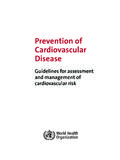Transcription of Chapter 2
1 Chapter 2 NCDs and development Chapter 2. NCDs and development Noncommunicable diseases have potentially serious socioeconomic consequences, through increasing individual and household impoverishment and hindering social and economic development. This Poverty is closely Chapter examines the relationship between NCDs and socioeconomic conditions. It demonstrates linked with NCDs, that the distribution and impact of NCDs and their risk factors is highly inequitable and imposes a and the rapid disproportionately large burden on low- and middle-income countries. Poverty is closely linked with rise in NCDs NCDs, and the rapid rise in the magnitude of these health problems is therefore predicted to impede poverty reduction initiatives in low-income countries and communities.
2 Finally, the Chapter argues is predicted to that scaling up global efforts to prevent and control NCDs will help accelerate the achievement of impede poverty the United Nations Millennium Development Goals (MDGs). reduction initiatives in low- Once thought of as diseases of the rich, NCDs are now the leading causes of death in low- and income countries middle-income countries. As mentioned previously, nearly 30% of NCD-related deaths in low- income countries occur under the age of 60, whereas in high-income countries the proportion is only 13%. Without targeted and sustained interventions, these health inequities are likely to widen, causing even greater individual, social and economic consequences.
3 NCDs are fundamentally a development and socioeconomic issue, striking both rich and poor people, but inflicting more ill- health and other consequences on the poor in all countries. Equity, social determinants and NCDs Structural determinants and the conditions of daily life constitute the social determinants of health and are crucial to explaining and addressing health inequities. As with other priority health issues, prevailing social and economic conditions influence people's exposure and vulnerability to NCDs, as well as related health-care outcomes and consequences (1). The rapidly growing burden of NCDs in developing countries is not only accelerated by population ageing; it is also driven by the negative effects of globalization, for example, unfair trade and irresponsible marketing, rapid and unplanned urbanization and increasingly sedentary lives.
4 People in developing countries eat foods with higher levels of total energy. Increasing NCD levels are being influenced by many factors including tobacco use and availability, cost and marketing of foods high in salt, fat and sugar. A considerable proportion of global marketing targets children and adolescents as well as women in developing countries to promote tobacco smoking and consumption of junk'. food and alcohol. Rapid, unplanned urbanization also changes people's way of living through more exposure to the shared risk factors. NCDs are exacerbated in urban areas by changes in diet and physical activity, exposure to air pollutants (including tobacco smoke) and harmful use of alcohol.
5 Overwhelmed by the speed of growth, many governments are not keeping pace with ever-expanding needs for infrastructure and services and people are less likely to be protected by interventions like smoke-free laws, regulations to phase out trans-fats, protections against harmful use of alcohol, and urban planning to promote physical activity. As a consequence, vulnerable and socially disadvantaged people get sicker and die sooner than people of higher social positions; the factors determining social positions include education, Vulnerable occupation, income, gender and ethnicity (2). and socially disadvantaged There is strong evidence on the links between poverty and lower life expectancy, and on the people get sicker associations between a host of social determinants, especially education, and prevalent levels of NCDs: people of lower social and economic positions fare far worse in countries at all levels of and die sooner development.
6 Than people of higher social In Singapore, for example, the prevalence of physical inactivity, daily smoking and regular alcohol positions consumption was found to be consistently highest among men and women with the least education (3). In the United States, an additional four years of schooling was associated with a decreased risk of heart disease and diabetes (4). In Australia, blue-collar workers have significantly higher levels of cancer and in Spain, female blue-collar workers had a higher incidence of metabolic 33. Chapter 2 NCDs and development syndrome compared to other female white-collar personnel (5, 6). Diabetes is more prevalent among immigrants in Australia and the Netherlands (7, 8), while immigrants in Canada also have higher mortality rates of ischaemic heart disease (9).
7 In Finland, consumption of saturated fat increased with decreasing individual income (10). Similarly, in low- and middle-income countries, an increasing number of studies show associations between NCDs and certain social determinants, particularly education and income levels. In China, lower education levels and urban residency are strongly associated with an increased risk of diabetes (11). The findings of a recent study in India also revealed that tobacco use, hypertension and physical inactivity were significantly more prevalent in lower education groups (12). In Viet Nam, cardiovascular mortality rates decreased among educated people compared to those without formal education, as is the case with harmful use of alcohol in Nepal (13, 14).
8 In South Africa, higher mortality from NCDs was found among the urban poor (15). Poor people are more likely to smoke in Bangladesh and India (16, 17). People in poor communities in South Africa are at greater risk of being exposed to a number of NCD risk factors, including second-hand smoke, excessive alcohol use and indoor air pollution, as well as suffering from asthma (18). In Brazil, obesity is higher among women with lower level of income (19). Evidence now shows that the poor may begin life with increased vulnerability to NCDs and are then exposed to additional risks throughout life. Under-nutrition in utero and low birth weight, particularly prevalent among low-income populations, increases the subsequent risk of cardiovascular disease and diabetes.
9 There is evidence that childhood socioeconomic status is associated with type 2 diabetes and obesity in later life (20). As a consequence, the poor are more likely to die prematurely from NCDs. The WHO Commission on Social Determinants of Health made an aspirational call for closing the health gap in a generation (2). To ensure that the call is fulfilled, focused research, coherent policies and multisectoral partnerships for action are required to expand the evidence base and implement interventions that show evidence of effectiveness in combating NCDs and their risk factors. Economic impact of NCDs on households In addition to the close links between poverty and NCD risk, the economic consequences of NCDs are also of critical importance.
10 In a World Bank qualitative survey of 60 000 poor women and men in 60 countries, sickness and injury was the most frequent trigger for downward mobility (21). At the household level, unhealthy behaviours, poor physical status, and the high cost of NCD-related health care, lead to loss of household income. People often become trapped in a dangerous cycle where poverty and NCDs continually reinforce one another. While measuring the economic impacts of NCDs remains a relatively complex and under-developed discipline, they invariably affect low- and middle-income countries and households more severely About 150 million because they have the least financial cushion to withstand the economic consequences of NCDs.














